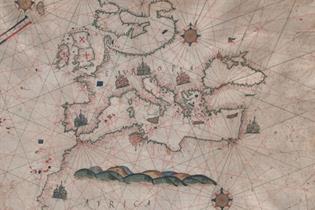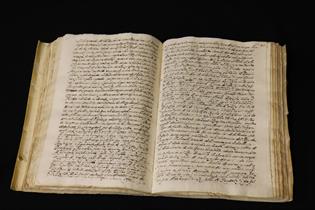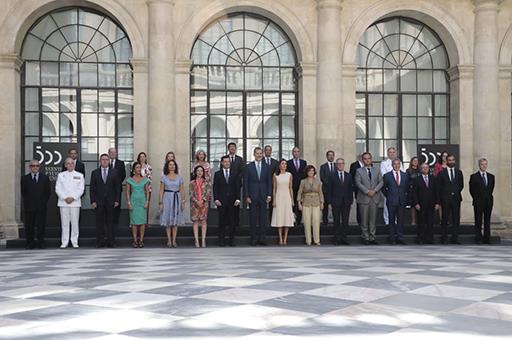At the General Archive of the Indies in Seville
King and Queen of Spain open commemorative exhibition on first circumnavigation by Magellan and Elcano
News - 2019.9.12
The exhibition, which is sponsored by the Unicaja Foundation, will remain open until 23 February at the General Archive of the Indies. Managed by the Spanish Ministry of Culture and Sport, the items kept by this institution include the largest collection of original documents relating to this achievement and can be found only a few metres away from the Guadalquivir moorings where this historic expedition was organised, set sail and returned.
The opening of this exhibition coincides with the plenary session of the 5th Magellan-Elcano Centenary National Commission in the regional capital of Andalusia, the honorary chair of which is held by King Felipe and Queen Letizia of Spain.
The King and Queen of Spain were accompanied at the official opening ceremony by the Acting Vice-President of the Government and Chair of the National Commission for this centenary, Carmen Calvo; the President of the Regional Government of Andalusia, Juan Manuel Moreno; the Mayor of Seville, Juan Espadas; the Acting Minister for Culture and Sport, José Guirao; the Acting Minister for Defence, Margarita Robles; the Acting Minister for the Treasury, María Jesús Montero; and the Central Government Delegate in Andalusia, Jesús Fernández Delgado, among other senior officials.
Besides telling the story of and commemorating the first circumnavigation as a key event in universal history, the exhibition commissioned by Antonio Fernández Torres and the lead archivists at the General Archive of the Indies, Guillermo Morán Dauchez and Braulio Vázquez Campos, also pays tribute to the explorational spirit of mankind and its approach to the unknown as the 50th anniversary of the first human moon landings is also being celebrated in 2019.
For the first time, this exhibition gathers into once place the most important documents and chronicles that have allowed the study and analysis of the first circumnavigation of our planet. It thus gives voice to and is narrated by the protagonists of that epic voyage begun by Ferdinand Magellan in 1519, which would go on to be the longest journey ever undertaken at the time - the first circumnavigation, and concluded by Juan Sebastián Elcano and his men of the Victoria in 1522.
Pool Moncloa / J. M. CuadradoA total of 106 original pieces and documents belonging to the General Archive of the Indies, various institutions in other European countries (such as the Torre de Tombo National Archive in Lisbon and the French National Library) and other Spanish institutions (such as the National Library of Spain, the Museum of the Americas, the Museum of Eastern Art in Valladolid and the Royal Academy of History), among many others, can be seen at the exhibition. Of particular note are the Treaty of Tordesillas, the sculpture of a young King Carlos I of Spain borrowed from the National Museum of Sculpture in Valladolid, historic editions of the chronicles of Pigafetta, Albo, Mafra and Genovés, the original carving of the Virgin from the Victoria venerated by the sailors upon their departure and return, and the letter from Maximiliano Transilvano.
This impressive historical heritage will be surrounded by environmental and emotional context made up by audio-visual elements and an original display design aimed at ensuring visitors gain a sense of the challenges posed by this ocean voyage and bringing the public closer through different, more human, methods to the history contained in the original documents. These efforts are enhanced by some important ship models by the model maker, Antonio Hierro, the seven sculptures produced by Javier Romero Abrio and 25 items of gold work. These compositions were directed by Antonio Fernández Torres and the design team who worked on the exhibition.
After its time in Seville, the exhibition will travel to the San Telmo Museum in San Sebastian between June and September 2020.
The exhibition: sections and context
The exhibition is divided into six main sections based on the various stages of the entire voyage of discovery: Dream, Departure, Exploration, Destination, Return and Transformation. Through them, visitors will enjoy a guided tour of direct testimonies from the protagonists, who together give shape to a rich and varied ship's log. This log, made up of extracts from the original documents on display, reconstructs the route of the first circumnavigation and comprises the backbone of the exhibition, which has been designed as a large conceptual map of the world that visitors explore from a bird's eye view as if produced by an orbiting satellite.
Dream
The first section of the exhibition, entitled "Dream", shows visitors the historic context and reasons that led to the formation of the Armada de Maluco [Maluco Navy]. Through Bartolomé de las Casas, visitors discover the historic presentation by Magellan at the Court of Valladolid, as well as the key aspects and protagonists of that time when the voyage switched from merely being an idea, a dream, to start becoming a real project. Various documents and pieces, such as the Treaty of Tordesillas, the Capitulations of the Spice Fleet and the bust of King Carlos I of Spain from the National Museum of Sculpture in Valladolid, support this first section.
Departure
Visitors enter the second section of the exhibition with the signing of the Capitulations. 16th-century Seville is recreated through the original lists of the supplies taken on board, the crew lists and the models of the five ships comprising Magellan's convoy, revealing the efforts and costs involved in organising an armada for the longest journey ever undertaken at the time. Interviews, sculptures and an audio-visual display give context to the moment of farewell and the start of that journey.
Exploration
 Ministerio de Cultura y DeporteThe third section - "Exploration" - begins with the ships now at sea. Guided by the chroniclers on the first circumnavigation, visitors can follow the various routes and stopovers on Magellan's voyage, stopping at the most important milestones through documents, maps and various ethnographic pieces.
Ministerio de Cultura y DeporteThe third section - "Exploration" - begins with the ships now at sea. Guided by the chroniclers on the first circumnavigation, visitors can follow the various routes and stopovers on Magellan's voyage, stopping at the most important milestones through documents, maps and various ethnographic pieces.
The displays and audio-visual elements give context to each part of the journey, revealing to visitors the weather and atmosphere in which the various events took place. The Strait of Magellan and the great ocean night of the Pacific are the star features of this section of the exhibition.
Destination
After the Pacific crossing and a radical change in surroundings, the exhibition enters its fourth section - "Destination" - to tell of the experiences undergone in the Philippines and the dangers encountered before the sailors reached their goal in the Maluku Islands. This section is marked by the death of Magellan, the rise of Juan Sebastián Elcano to captaincy of the Victoria and the arrival of the armada in Tidore in the Maluku Islands. The Santo Niño de Cebú, borrowed from the Museum of Eastern Art in Valladolid, and the important document known as "Las Paces del Maluco" are the centrepieces of this section.
Return
The final section of the exhibition begins after setting sail from the Maluku Islands - "Return". Storms and the great ocean void feature heavily in this section, which seeks to highlight the scope and technical challenge of the non-stop voyage by Juan Sebastián Elcano and his men aboard the Victoria. Such 16th-century sailing manuals as those by García de Palacio and Escalante de Mendoza, borrowed from the University of Salamanca and the National Library of Spain, documents from the Torre do Tombo in Lisbon and the sailing directions of Francisco Albo guide visitors through that tremendous and seemingly endless return voyage that made the first circumnavigation possible.
Transformation
 Ministerio de Cultura y DeporteThe final section of the exhibition features the ship's return to Seville and the repercussions of the voyage at the time and through history. The section includes the original carving of the Virgin from the Victoria, borrowed from the Iglesia de Santa Ana de Triana, an icon that - venerated by Ferdinand Magellan - bore witness to the swearing in of the armada captains before their departure and to Juan Sebastián Elcano and the survivors from the Victoria when they went to give thanks after disembarking in Seville.
Ministerio de Cultura y DeporteThe final section of the exhibition features the ship's return to Seville and the repercussions of the voyage at the time and through history. The section includes the original carving of the Virgin from the Victoria, borrowed from the Iglesia de Santa Ana de Triana, an icon that - venerated by Ferdinand Magellan - bore witness to the swearing in of the armada captains before their departure and to Juan Sebastián Elcano and the survivors from the Victoria when they went to give thanks after disembarking in Seville.
The letters from Juan Sebastián Elcano to King Carlos V of Spain and from Maximiliano Transilvano to Matthäus Lang von Wellenburg, Cardinal Archbishop of Salzburg and Bishop of Cartagena, conclude the exhibition.
The Dream...
But the longest journey does not end here. In a final room, the last will and testament of Juan Sebastián Elcano and the sailing directions of Andrés Urdaneta provide an epilogue and gateway to the audio-visual piece entitled "The Dream", where visitors discover the real key to the longest journey. A journey that continues today.
Non official translation





